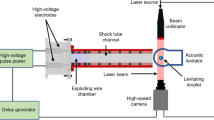Abstract
The tribological properties of four phenyl ether lubricants, monoalkydiphenyl ether (MADE), dialkyldiphenyl ether (DADE), m-phenoxyphenoxy m-biphenyl (m-4P2E), and m-bis(m-phenoxyphenoxy) benzene (m-5P4E), confined between mica surfaces have been investigated using the resonance shear measurement (RSM). The RSM study revealed that the viscous parameter of these lubricants increased when they were confined in a nano-space. The viscous parameter b 2 values of these lubricants confined in a gap smaller than ca. 2–3 nm were in the order of MADE > DADE > m-4P2E ≈ m-5P4E, while their bulk viscosities were in the order of m-5P4E > m-4P2E > DADE > MADE. Further, the MADE, which has better hydrodynamic lubrication property because of the lowest bulk viscosity, was relatively easily squeezed out from the gap compared to others. These results have demonstrated that phenyl ether lubricants confined in a nano-space behave quite differently from those of the bulk phase, and the direct characterization of confined lubricants is imperative for designing efficient lubricants, especially for boundary lubrication.






Similar content being viewed by others
Notes
The intensity and frequency of the AS and MC peaks for DADE were different from those observed for MADE (Fig. 4a). This was caused by the change in the effective spring constants and viscous parameters of the upper and lower units due to the disassembly and assembly of the apparatus. Thus, we always measured the AS and MC resonance curves for the each set of measurements as the references for the physical model analysis.
References
Horn, R.G., Israelachvili, J.N., Perez, E.: J. Phys. 42, 39 (1981)
Horn, R.G., Israelachvili, J.N.: J. Chem. Phys. 75, 1400 (1981)
Israelachvili, J.N., MacGuiggan, P.M., Homola, A.H.: Science 240, 189 (1988)
Gee, M.L., MacGuiggan, P.M., Israelachvili, J.N., Homola, A.M.: J. Chem. Phys. 93, 1895–1906 (1990)
Peachey, J., Alsten, J.V., Granick, S.: Rev. Sci. Instrum. 62, 463 (1991)
Granick, S.: Science 253, 1374 (1991)
Klein, J., Kumacheva, E.: J. Chem. Phys. 108, 6996 (1998)
Kumacheva, E., Klein, J.: J. Chem. Phys. 108, 7010 (1998)
Dushkin, C., Kurihara, K.: Colloids Surf. A Physicochem. Eng. Asp. 129–130, 131 (1997)
Dushkin, C., Kurihara, K.: Rev. Sci. Instrum. 69, 2095 (1998)
Mizukami, M., Kurihara, K.: Rev. Sci. Instrum. 79, 113705 (2008)
Sakuma, H., Kurihara, K.: Rev. Sci. Instrum. 80, 013701 (2009)
Gao, J., Luedtke, W.D., Landman, U.: J. Chem. Phys. 106, 4309 (1997)
Matsubara, H., Pichierri, F., Kurihara, K.: Phys. Rev. Lett. 109, 197801 (2012)
Fujii, Y., Kakehi, T.: J. Jpn. Soc. Tribol. 47, 187 (1997)
Trivedi, H.K., Klenke, C.J., Saba, C.S.: Tribol. Lett. 17, 1 (2004)
Hayashi, S., Abe, T., Higashi, N., Niwa, M., Kurihara, K.: Langmuir 18, 3932 (2002)
Israelachvili, J.N.: J. Colloid Interface Sci. 44, 259 (1973)
Mizukami, M., Kusakabe, K., Kurihara, K.: Prog. Colloid Polym. Sci. 128, 105 (2004)
Sakuma, H., Otsuki, K., Kurihara, K.: Phys. Rev. Lett. 96, 046104 (2006)
Kayano, Y., Sakuma, H., Kurihara, K.: Langmuir 23, 8365 (2007)
Kayano, Y., Sakuma, H., Kurihara, K.: Trans. MRS-J 32, 367 (2007)
Kawai, H., Sakuma, H., Mizukami, M., Abe, T., Fukao, Y., Tajima, H., Kurihara, K.: Rev. Sci. Instrum. 79, 043701 (2008)
Acknowledgments
This work was supported by the “Green Tribology Innovation Network” in the area of Advanced Environmental Materials of Green Network of Excellence (GRENE) program and “Ultra-low Friction Technology Area” in the Tohoku Innovative Materials Technology Initiatives for Reconstruction from the Ministry of Education, Culture, Sports, Science, and Technology of Japan.
Author information
Authors and Affiliations
Corresponding author
Electronic supplementary material
Below is the link to the electronic supplementary material.
Rights and permissions
About this article
Cite this article
Watanabe, J., Mizukami, M. & Kurihara, K. Resonance Shear Measurement of Confined Alkylphenyl Ether Lubricants. Tribol Lett 56, 501–508 (2014). https://doi.org/10.1007/s11249-014-0427-8
Received:
Accepted:
Published:
Issue Date:
DOI: https://doi.org/10.1007/s11249-014-0427-8




